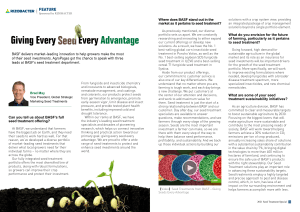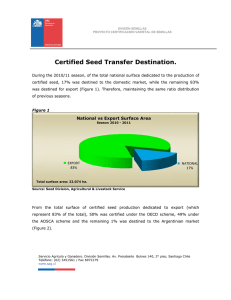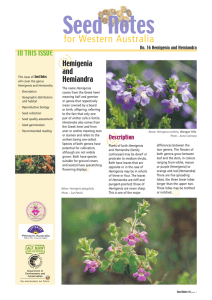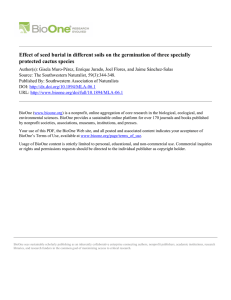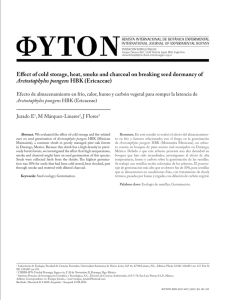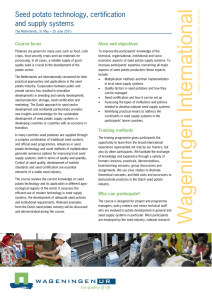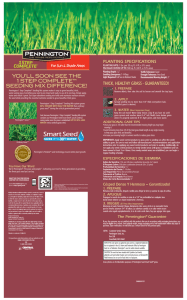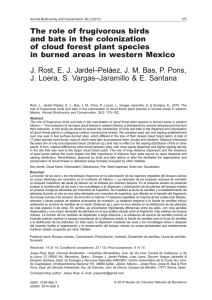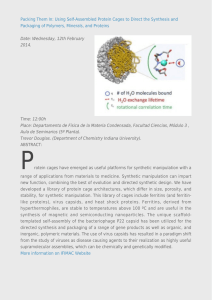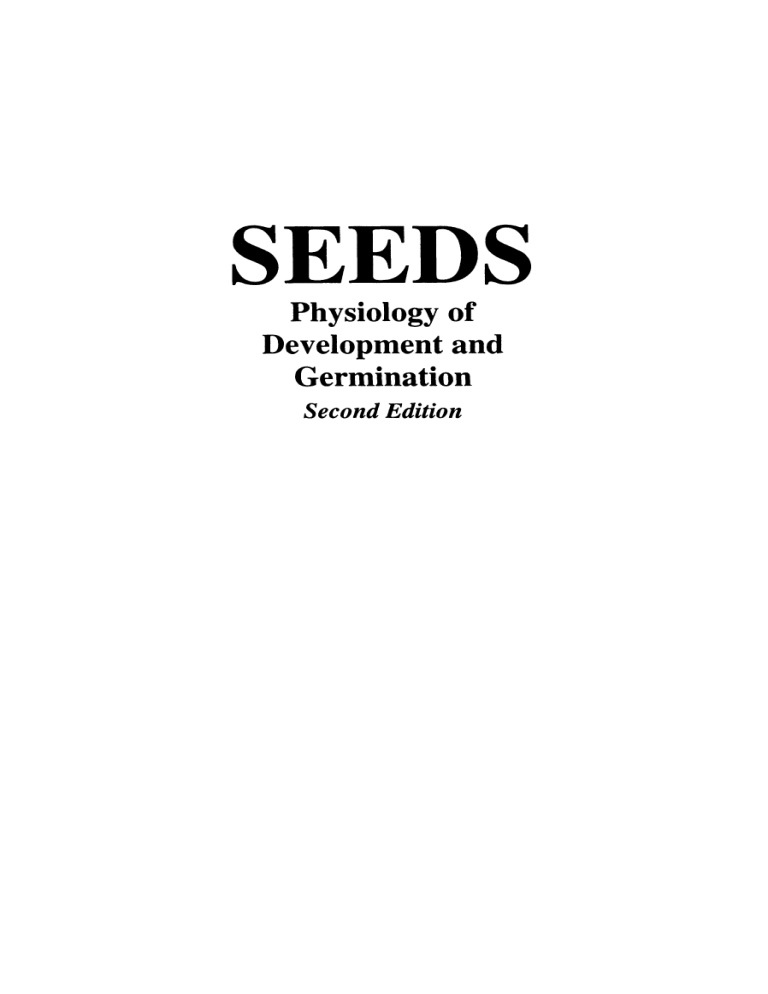
SEEDS Physiology of Development and Germination Second Edition SEEDS Physiology of Development and Germination Second Edition J. Derek Bewley Department of Botany University of Guelph Guelph, Ontario, Canada and Michael Black Division of Life Sciences King's College University of London London, England Springer Science+Business Media, LLC Library of C o n g r e s s Cataloging-in-Publication Data Bewley, J . Derek, 1943Seeds : physiology of development and germination / J . Derek Bewley and Michael Black. — 2 n d e d . p. cm. Includes bibliographical references and index. 1. S e e d s — D e v e 1 opinent. II. Title. QK661.B49 1994 582' . 0 4 6 7 — d c 2 0 2. G e r m i n a t i o n . I. B l a c k , Michael. 94-19278 CIP J. Derek Bewley Department of Botany University of Guelph Guelph, Ontario N1G 2W1 Canada Michael Black Division of Life Sciences King's College University of London London W8 7AH England ISBN 978-0-306-44748-8 DOI 10.1007/978-1-4899-1002-8 ISBN 978-1-4899-1002-8 (eBook) © Springer Science+Business Media New York 1994 Originally published by Plenum Press, New York in 1994 Softcover reprint of the hardcover 2nd edition 1994 All rights reserved No part of this book may be reproduced, stored in a retrieval system, or transmitted in any form or by any means, electronic, mechanical, photocopying, microfilming, recording, or otherwise, without written permission from the Publisher Though I do not believe that a plant will spring up where no seed has been, I have great faith in a seed. Convince me that you have a seed there, and I am prepared to expect wonders. Henry D. Thoreau Preface to the Second Edition Since the publication of the first edition of this book there have been enormous advances in certain areas of the subject, particularly those which are amenable to study using the techniques and approaches of molecular biology and mutant technology. This is especially apparent with respect to seed development, effects of abscisic acid and gibberellin on gene expression and certain aspects of dormancy. Sections of the book dealing with these topics have been extensively revised, to incorporate new information and concepts. In one case-seed development-it has been necessary to allocate two chapters to the subject, to separate reserve synthesis and its regulation from the more developmental aspects of embryogenesis and seed maturation. As in the previous edition, we have been mindful throughout of placing our discussion and considerations firmly in the context of the seed, and where new knowledge at the molecular level is included we have attempted always to emphasize its special relevance to seed biology. The reader will discern that some sections have been altered relatively little from their state in the previous edition. These are areas in which, at least according to our perceptions, advances have been more modest, especially as regards the development of new concepts and interpretations. But some of these are now opening up to the new approaches which are already having such substantial impact in the realm of seed physiology. We are grateful to those who have helped us in the production ofthis book. Many researchers have contributed material or given us permission to use their published findings. Laurie Winn of the Department of Botany, University of Guelph, has done sterling work in converting our scrawl into a splendidly presented transcript. Our thanks also to Sherry Hall, at Guelph, for helping out when the pressure became too high. The wonders of computer technology have been effectively harnessed by Wenjin Yu of the same Department in the production of many of the illustrations. We express our sincere appreciation of their skills and patience. J.D. Bewley M. Black vii Contents Chapter 1 Seeds: Germination, Structure, and Composition 1.1. 1.2. 1.3. 1.4. Introduction ............................................. . Seed Germination-Some General Features ................... Measurement of Germination ............................... Seed Structure . . . . . . . . . . . . . . . . . . . . . . . . . . . . . . . . . . . . . . . . . . . . 1.4.1. Embryo........................................... 1.4.2. Nonembryonic Storage Tissues ....................... 1.4.3. Seed Coat (Testa) . . . . . . . . . . . . . . . . . . . . . . . . . . . . . . . . . . . 1.5. Seed Storage Reserves ..................................... 1.5.1. Carbohydrates ..................................... 1.5.2. Fats and Oils (Neutral Lipids) . . . . . . . . . . . . . . . . . . . . . . . . . 1.5.3. Proteins........................................... 1.5.4. Phytin ............................................ 1.5.5. Other Constituents . . . . . . . . . . . . . . . . . . . . . . . . . . . . . . . . .. 1 2 5 7 8 10 10 12 16 18 30 31 Chapter 2 Seed Development and Maturation 2.1. Embryogeny and Storage Tissue Formation. . . . . . . . . . . . . . . . . . . . 2.1.1. Morphological Changes ............................. 2.1.2. Regulation of Development .......................... 2.2. Source of Assimilates for Grain and Seed Filling ............... 2.2.1. Cereals ........................................... 2.2.2. Legulnes.......................................... ix 35 35 39 40 41 42 x Contents 2.2.3. Translocation of Assimilates into the Developing Seed. . . . 2.2.4. Environmental Effects on Seed Development . . . . . . . . . . . . 2.3. Deposition of Reserves within Storage Tissues ... . . . . . . . . . . . . . . 2.3.1. Starch Synthesis ................................... 2.3.2. Deposition of Polymeric Carbohydrates Other Than Starch 2.3.3. Triacylglycerol Synthesis. . . . . . . . . . . . . . . . . . . . . . . . . . . . 2.3.4. Storage Protein Synthesis . . . . . . . . . . . . . . . . . . . . . . . . . . . . 2.3.4.1. Cereals ................................... 2.3.4.2. Dicots.................................... 2.3.4.3. Modifications to Synthesized Storage Proteins, Their Sorting and Targeting to Protein Bodies ... 2.3.4.4. Seed mRNA Content and Storage Protein Synthesis ................................. 2.3.5. Regulation of Storage Protein Synthesis ................ 2.3.5.1. Investigating Gene Expression in Seeds ........ 2.3.5.2. Expression of Storage Protein Genes. . . . . . . . . . . 2.3.5.3. Nutritional Effects on Storage Protein Synthesis. 2.3.5.4. Abscisic Acid and the Osmotic Factor. . . . . . . . . . 2.3.5.5. Molecular Action of ABA ................... 2.3.5.6. Mutants, Protein Content, and Nutritional Quality of Seeds ........................... 2.3.6. Phytin Deposition .................................. 2.4. Hormones in the Developing Seed ........................... 2.4.1. Composition and Location. . . . . . . . . . . . . . . . . . . . . . . . . .. 2.4.1.1. Auxins ................................... 2.4.1.2. Gibberellins ............................... 2.4.1.3. Cytokinins ................................ 2.4.1.4. ABA..................................... 2.4.2. Possible Roles of Seed Hormones ..................... 2.4.2.1. Seed Growth and Development ............... 2.4.2.2. Fruit Growth and Development ............... 2.4.2.3. Hormones for Germination and Growth ........ 2.4.2.4. Other Effects of the Seed Hormones ........... 44 50 51 52 58 60 68 68 73 74 81 83 84 86 92 92 95 97 99 100 101 101 102 104 104 105 105 109 110 110 Chapter 3 Development-Regulation and Maturation 3.1. Germinability during Development .......................... 117 3.2. Viviparous Mutants and Precocious Germination ............... 119 3.3. Maturation Drying and the "Switch" to Germination ............ 124 Contents 3.3.1. The Acquisition of Desiccation Tolerance ............... 3.3.2. Changes in Metabolism Associated with Drying ......... 3.3.3. Metabolic Changes on Rehydration following Desiccation. 3.3.4. Seed Germination without Prior Desiccation ............ 3.4. The Dry Seed ............................. ; .............. 3.4.1. Bound Water and Vitrification ........................ 3.4.2. Metabolism in the Dry State .......................... 3.5. Recalcitrant Seeds. . . . . . . . . . . . . . . . . . . . . . . . . . . . . . . . . . . . . . . .. xi 124 126 131 134 136 136 138 140 Chapter 4 Cellular Events during Germination and Seedling Growth 4.1. Imbibition ............................................... 4.1.1. Uptake ofWaterfrom the Soil ........................ 4.1.2. Water Uptake by Seeds ............................ " 4.1.3. Soaking Injury and Solute Leakage .................... 4.2. The Completion of Germination: Radicle Elongation and Its Control. . . . . . . . . . . . . . . . . . . . . . . . . . . . . . . . . . . . . . . . . . . . . . . . .. 4.3. Respiration-Oxygen Consumption .......................... 4.3.1. Pathways, Intermediates, and Products ................. 4.3.2. Respiration during Imbibition and Germination .......... 4.4. Mitochondrial Development and Oxidative Phosphorylation ...... 4.4.1. Site of ATP Production during Early Imbibition .......... 4.4.2. The Route of Electrons between Substrate and Molecular Oxygen ........................................... 4.4.3. Mitochondrial Development in Imbibed Seeds ........... 4.4.4. ATP Synthesis during Germination .................... 4.4.5. The Synthesis and Utilization of Reducing Power: Pyridine Nucleotides ................................ 4.5. Respiration under Anaerobic Conditions ...................... 4.6. Protein Synthesis during Germination and Its Dependence on mRNA Synthesis. . . . . . . . . . . . . . . . . . . . . . . . . . . . . . . . . . . . . . . . .. 4.6.1. Protein Synthesis in Germinating Embryos and Axes. . . . .. 4.6.2. Ribosomal and Transfer RNA Synthesis ................ 4.6.3. Enzymes and Precursors of RNA Synthesis ............. 4.6.4. Protein and RNA Synthesis in Storage Tissues. . . . . . . . . .. 4.7. DNA Synthesis and Cell Division .......................... " 4.8. Seedling Development. . . . . . . . . . . . . . . . . . . . . . . . . . . . . . . . . . . .. 147 147 149 153 155 160 160 161 163 163 164 167 171 172 175 178 178 185 187 187 188 191 xii Contents Chapter 5 Dormancy and the Control of Germination 5.1. Introduction ............................................. 5.2. Internal Controls. . . . . . . . . . . . . .. . . . . . . . . . . . . . . . . . . . . . . . . . .. 5.2.1. Dormancy-Its Biological Role. . . . . . . . . . . . . . . . . . . . . .. 5.2.2. Categories of Dormancy. . . . . . . . . . . . . . . . . . . . . . . . . . . .. 5.2.3. Mechanism of Dormancy ............................ 5.2.4. Embryo Dormancy-The Inherent Constraints ........... 5.2.5. Coat-Imposed Dormancy-The Constraints ............. 5.2.5.1. Interference with Water Uptake ............. " 5.2.5.2. Mechanical Restraint. . . . . . . . . . . . . . . . . . . . . . .. 5.2.5.3. Interference with Gas Exchange. . . . . . . . . . . . . .. 5.2.5.4. Prevention of Exit ofInhibitors ............... 5.2.5.5. Supply of Inhibitors to the Embryo ............ 5.2.6. Coat-Imposed Dormancy-A Summary ................ 5.3. Embryonic Inadequacy-the Causes ......................... 5.3.1. Metabolism of Dormant Seeds .. . . . . . . . . . . . . . . . . . . . . .. 5.3.2. Gene Expression and Dormancy ...................... 5.3.3. Membranes and Dormancy ........................... 5.4. Development of Dormancy ................................. 5.4.1. When Does Primary Dormancy Occur? ................ 5.4.2. Genetic Control of Dormancy ........................ 5.4.3. Correlative Effects in Dormancy ...................... 5.4.4. Dormancy Induction by Abscisic Acid ................. 5.4.5. The Environment in Dormancy Inception. . . . . . . . . . . . . .. 5.4.6. Development of Hard Coats ............ . . . . . . . . . . . . .. 5.4.7. Secondary Dormancy ............................... 5.5. The External Controls ..................................... 5.5.1. The Release from Dormancy ......................... 5.5.1.1. Afterripening .............................. 5.5.1.2. Low Temperatures (Chilling) ................. 5.5.1.3. Other Effects of Temperature on Dormancy ..... 5.5.1.4. Light ..................................... 5.5.1.5. Seeds with Impermeable Coats ............... 5.5.1.6. Breaking of Dormancy by Chemicals .......... 5.5.1.7. The Mechanism of Dormancy Release ......... 5.5.1.8. Hormones in Dormancy Breaking ............. 5.5.1.9. Dormancy Breakage and Metabolism .......... 5.5.1.10. Dormancy Breakage and Cell Enlargement ...... 5.5.2. Environmental Control of Germination. . . . . . . . . . . . . . . .. 199 199 199 201 203 203 206 206 207 208 213 214 215 215 215 217 218 220 220 221 222 222 226 229 230 230 231 231 232 236 237 247 247 248 250 253 257 258 xiii Contents 5.6. 5.5.2.1. Effects of Light ............................ 5.5.2.2. Inhibition by Short Periods of Far-Red Light .... 5.5.2.3. Effects of Temperature ...................... 5.5.2.4. Water Stress ............................... 5.5.2.5. Oxygen and Carbon Dioxide .................. Control of Germination-A Summary ................. , 259 262 262 266 266 267 Chapter 6 Some Ecopbysiological Aspects of Germination 6.1. Introduction.............................................. 273 6.2. Seed Burial .............................................. 273 6.2.1. The Seed Bank .................................... , 273 6.2.2. Light and Seed Burial ............................... 274 6.3. Germination in Direct Sunlight .............................. 277 6.4. Germination under Leaf Shade .............................. 277 6.5. Temperature ............................................. 279 6.6. Water ................................................... 282 6.7. Interactions .............................................. 284 6.8. Secondary Dormancy and Seasonal Germination ............... 284 6.9. Germination, Plant Distribution, and Plant Origin ............... 286 6.10. Chemicals in the Natural Environment .. " .................... 289 Chapter 7 Mobilization of Stored Seed Reserves 7.1. Stored Carbohydrate Catabolism . . . . . . . . . . . . . . . . . . . . . . . . . . . .. 7.1.1 Pathways of Starch Catabolism ......................... 7.1.2. Synthesis of Sucrose ................................ 7.2. Mobilization of Stored Carbohydrate Reserves in Cereals ........ 7.2.1. The Embryo Reserves ............................... 7.2.2. The Endosperm Reserves ............................ 7.2.3. The Fate of the Products of Starch Hydrolysis ........... 7.3. Mobilization of Stored Carbohydrate Reserves in Legumes ....... 7.3.1. Nonendospermic Legumes ........................... 7.3.2. Endospermic Legumes .............................. 7.4. Hemicellulose-Containing Seeds Other Than Legumes ........... 7.5. Stored Triacylglycerol Catabolism ........................... 293 293 295 296 296 296 302 303 303 305 310 311 Contents xiv 7.5.1. 7.5.2. 7.5.3. 7.5.4. General Catabolism. . . . . . . . . . . . . . . . . . . . . . . . . . . . . . . .. Mobilization of Triacylglycerols from Oil Bodies ........ The Fate of Glycerol and Fatty Acids .................. Role of the Glyoxysome, Mitochondrion, and Cytosol in Gluconeogenesis ................................... 7.5.5. Glyoxysome Biosynthesis and Degradation ............. 7.5.6. Utilization of the Products of Triacylglycerol Catabolism.. 7.6. Stored Protein Catabolism . . . . . . . . . . . . . . . . . . . . . . . . . . . . . . . . .. 7.6.1. General Catabolism ................................. 7.6.2. Protein Mobilization in Cereals ....................... 7.6.3. Protein Mobilization in Dicots ........................ 7.6.4. Proteinase Inhibitors ................................ 7.6.5. Utilization of the Liberated Amino Acids. . . . . . . . . . . . . .. 7.7. Stored Phosphate Catabolism ............................... 7.7.1. General Catabolism ................................. 7.7.2. Phosphate Catabolism in Seeds ....................... 7.8. Mobilization of Nucleic Acids from the Storage Regions. . . . . . . .. 311 314 316 317 318 322 323 323 324 328 330 334 338 338 338 341 Chapter 8 Control of the Mobilization of Stored Reserves 8.1. Control of Reserve Mobilization in Cereals . . . . . . . . . . . . . . . . . . .. 8.1.1. Gibberellin and the Induction of a-Amylase Synthesis .... 8.1.2. Regulation ofthe a-Amylase Genes ................... 8.1.3. Enzyme Secretion .................................. 8.1.4. Regulation of a-Amylase Production within the Intact Grain ............................................ 8.1.5. Regulation of Other Hydrolases in the Cereals. . . . . . . . . .. 8.2. Control Processes in other Seeds ............................ 8.2.1. When Are the Mobilizing Enzymes Produced? .......... 8.2.2. Regulation of Mobilization. . . . . . . . . . . . . . . . . . . . . . . . . .. 8.2.3. Mode of Regulation by the Axis ...................... 8.2.3.1. Hormonal Control by the Axis ................ 8.2.3.2. The Axis as a Sink. . . . . . . . . . . . . . . . . . . . . . . . .. 345 346 351 355 357 361 365 366 367 370 371 372 Contents xv Chapter 9 Seeds and Germination: Some Agricultural and Industrial Aspects 9.1. Introduction .............................................. 9.2. Malting ................................................. 9.3. Preharvest Sprouting in Cereals .............................. 9.3.1. The Physiology of Preharvest Sprouting in Wheat ........ 9.4. Viability and Longevity of Seeds ............................ 9.4.1. Ancient Seeds ...................................... 9.4.2. Viability of Seeds in Storage ......................... 9.4.2.1. The Relationship between Temperature and Moisture during Storage ..................... 9.4.2.2. Other Factors That Affect Seed Viability during Storage ................................... 9.4.2.3. Microflora and Seed Deterioration . . . . . . . . . . . .. 9.4.3. Seed Storage Facilities .............................. 9.4.3.1. Short-Term Storage ......................... 9.4.3.2. Long-Term Genetic Conservation-Seed Gene Banks .................................... 9.4.4. Metabolic Consequences and Causes of Viability Loss .... 9.4.5. Damage to Chromosomes and DNA ................... 9.4.6. Aging and the Deterioration of Membranes ............. 9.5. Somatic Embryogenesis .................................... 9.5.1. Somatic Embryos and Synthetic Seed Production ......... 377 378 382 385 388 388 391 391 395 397 398 398 399 402 405 408 410 416 Index ........................................................ 421
